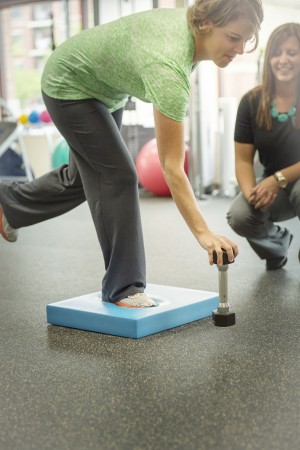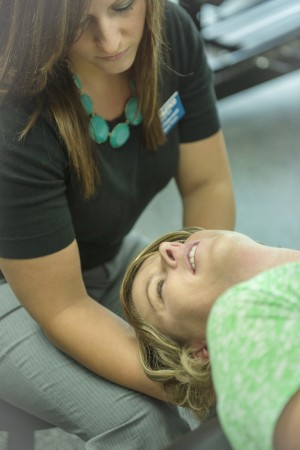
6 Conditions You May Not Realize Physical Therapists Treat
4 CommentsEvery year in October, we celebrate National Physical Therapy Month. There are many individuals that have seen a physical therapist (PT) for common reasons such as low back pain or knee pain. There are many different conditions, however, that PTs may treat that you may not be aware of. In order to keep up their professional license, PTs are required to take continuing education courses. Often, these courses may give a therapist a special set of skills for treating a certain condition or diagnosis. The following is a list of conditions that many individuals may not be aware that can be treated by a PT.
- Vertigo: Vertigo is a spinning sensation and can occur even when you are perfectly still. The most common form of vertigo is benign paroxysmal positional vertigo (BPPV). This is a mechanical inner ear problem that causes short periods of this spinning sensation when the head is moved in certain positions. When treated by a PT, positional vertigo can be eliminated in as little as one session.
 Concussion: In recent years, concussions have received a lot of attention in the news as doctors and athletes are seeking ways to manage long term problems brought on by a concussion. These long term issues can include dizziness/vertigo, balance problems, or complaints of headaches, all of which can be treated by a PT. There is a very specific balance of returning to normal activities with symptom management to allow the individual who had the concussion to fully recover.
Concussion: In recent years, concussions have received a lot of attention in the news as doctors and athletes are seeking ways to manage long term problems brought on by a concussion. These long term issues can include dizziness/vertigo, balance problems, or complaints of headaches, all of which can be treated by a PT. There is a very specific balance of returning to normal activities with symptom management to allow the individual who had the concussion to fully recover.- Temporomandibular joint dysfunction, or jaw pain: Jaw pain can be due to many different problems, but one of the biggest includes poor posture which leads to increased stress on the joint. A PT can address postural issues, assess and improve the alignment of the joint, as well as improve joint mobility to reduce pain.
- Urinary Incontinence: Most common in women, incontinence can be due to many different conditions including pregnancy, childbirth, surgery, pelvic floor weakness or spasm, or overall deconditioning. A PT can help to strengthen the proper muscles with a variety of techniques. Depending on your symptoms, a PT may recommend using a biofeedback tool where electrodes may be placed vaginally to provide measurements of muscle activity. This can help teach a patient to relax or contract the pelvic floor muscles to help decrease symptoms.
 Headaches: There are many different type of headaches including tension headaches, migraines and cluster headaches to name a few. Often times, headaches can become a very frequent occurrence that affects a persons ability to function on a daily basis. The most common type of headaches may be caused by poor posture, stress, muscle tightness, or a neck injury. A PT can help to determine the type of headaches and what the best treatments may be to help alleviate symptoms. A PT can perform manual massage to help loosen up tight muscles and can teach the patient about proper posture of the neck and upper body to decrease stress and tension through this area that might be leading to these headaches.
Headaches: There are many different type of headaches including tension headaches, migraines and cluster headaches to name a few. Often times, headaches can become a very frequent occurrence that affects a persons ability to function on a daily basis. The most common type of headaches may be caused by poor posture, stress, muscle tightness, or a neck injury. A PT can help to determine the type of headaches and what the best treatments may be to help alleviate symptoms. A PT can perform manual massage to help loosen up tight muscles and can teach the patient about proper posture of the neck and upper body to decrease stress and tension through this area that might be leading to these headaches.- Lymphedema: Lymphedema is swelling that may occur in the arms and legs that is stemming from your lymphatic system. It is very common after certain type of cancer treatments, such as breast cancer, where lymph nodes may be removed. A trained PT can perform certain types of lymphatic drainage massage or use certain wrapping techniques to help decrease swelling in a limb.
Athletico is now offering appointments in-clinic or virtually through telehealth. Request your free assessment using the button below.
The Athletico blog is an educational resource written by Athletico employees. Athletico bloggers are licensed professionals who abide by the code of ethics outlined by their respective professional associations. The content published in blog posts represents the opinion of the individual author based on their expertise and experience. The content provided in this blog is for informational purposes only, does not constitute medical advice and should not be relied on for making personal health decisions.

4 Comments
Connie Coin
And wound care
Educainment 10.11.13 | Mike Scott, DPT
[…] Six conditions you didnt know PTs treated. Pudendal Nerve entrapment didnt make the list. […]
Frank
Physical therapists are health care professionals who diagnose and manage individuals of all ages who have musculoskeletal problems or other health-related conditions that limit their abilities to move and perform functional activities in their daily lives. Physical therapists examine each individual and develop a plan of care using treatment techniques to promote the ability to move, reduce pain, restore function, and prevent disability. Physical therapists also work with individuals to prevent the loss of mobility by developing fitness- and wellness-oriented programs for healthier and more active lifestyles.
Richard Jones
It is good to hear all these treatments can be done with the help of an expert physical therapist. I visit my friend who is a physical therapist for past twelve years often to treat my back pain. He used to say at his place they treat a good variety of patients with a variety of illness. I didn’t knew they can treat temporomandibular joint dysfunction. When my uncle had a severe jaw pain problem a few months back, we contacted his dentist. He recommended to a popular orthodontic treatment center which has orthodontists specialized in tmj dysfunction treatment. We followed his recommendation and had a very successful treatment. I am not sure about physical therapists way of tmj treatment, but after I saw how well orthodontists treat my uncle I feel it is the best way to treat such kind of illness.